Deer seasons in the UK. When can deer be hunted?
The deer seasons in the UK have been precisely organised to give deer protection when they need it, to produce…
Win CENS ProFlex DX5 earplugs worth £1,149 – enter here
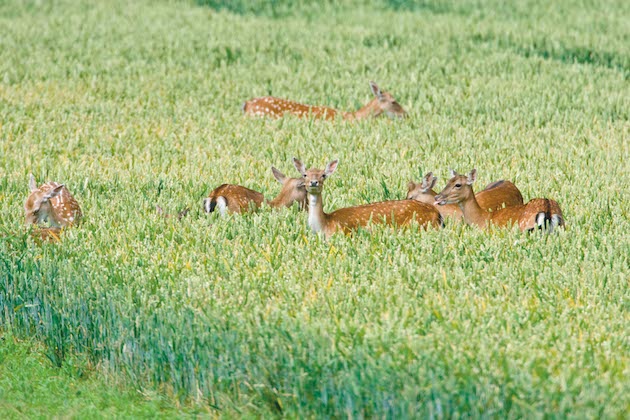
Deer management in any landscape requires a coordinated and well-thought-out plan. When it comes up in conversation, as it does more regularly than one would imagine, the viewpoint of those unfamiliar with deer management is more often than not, “Isn’t the aim simply to shoot as many as possible?”
While that may be the case in some isolated situations where deer populations are out of control, in most cases deer management is about maintaining a healthy and balanced population and to reduce and mitigate the impacts that deer can have.
Deer management can be an emotive topic and has to be handled sensitively. This has caused some landowners to shy away from it, and the knock-on effects can be stark. Those who do not shy away, however, are likely to see the benefits.
Coordinated deer management on the estate where I work has never been high on the list of priorities. However, with significant work being undertaken to bring together an estate-wide woodland management plan, and a requirement for a deer-management plan to form part of that, the need for action on deer came to the fore.
As we started out on the process of creating a deer-management plan, it became clear that we needed help, not only to pull together all relevant information required but also to provide us with impartial advice in order for us to achieve the best outcomes. Local deer adviser Bob Smith was more than happy to aid us. He provided us with the necessary advice and also helped to allow larger-scale coordination across the estate and to help us measure and reflect on the plan’s impact.
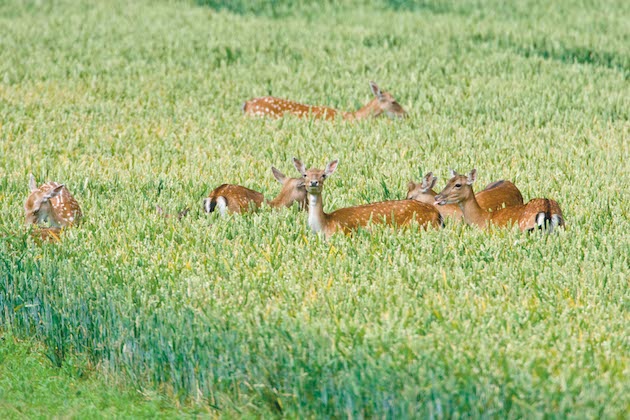
Fallow deer often use fields as a place to sleep, sometimes destroying corps in the process
There are a number of reasons why it has been an important step for us to engage more proactively with coordinated deer management. Deer pressures vary depending on the species, the topography and the population size, among other factors. On the estate, though we are beginning to see an increase in the number of roe deer, we have seen pressure mostly from muntjac and fallow, which manifests itself in a number of ways. Large areas of former bluebell woods have seen steep decline as deer have moved in, which is seen rather starkly in Long Wood, where a quarry towards one end of the wood generally keeps the deer away from the area and the bluebells bloom in the spring, producing a rich sea of colour, carpeting the woodland floor. The further away from the quarry you go, the deer are disturbed less and are therefore more prevalent. The result is a gradual change from beautiful bluebell woods to thick brambled understorey. The deer here are causing a significant change in woodland habitat – as a result we are losing flora and fauna and seeing a crash in biodiversity.
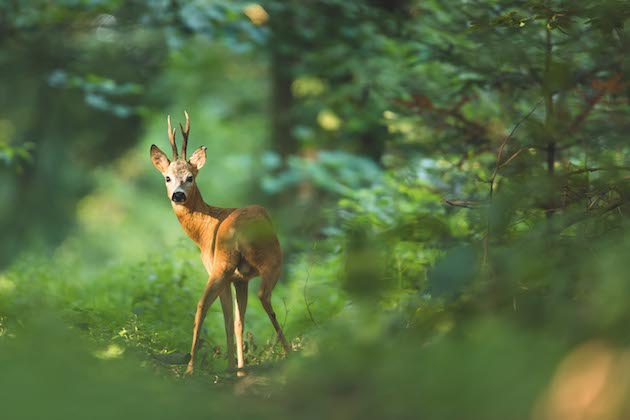
The estate is beginning to see an increase in the number of roe deer
Another impact is on farmland. Where arable fields neighbour woodland with higher deer numbers, the fallow in particular graze heavily on the cereal crops, with the larger bucks often using fields as a place to sleep, sometimes destroying crops in the process. The financial impact on farmers can be significant.
The most noteworthy impact for us, however, has been the damage to woodland across the estate and, more particularly, to young plantations. Unless parcels are completely deer-proof, or the trees are put in taller guards, there is little chance of the woodland getting beyond the first few years. The protection of young trees from deer can make planting projects financially unviable and landowners may opt to leave a woodland standing, when a clear fell and replant may be a more suitable management option.
On the estate, there has been an increase in damage over the past few years to mature sycamore trees, which hasn’t been seen previously. Bob confirmed that this was not unique and it seems there is a general trend towards more damage to trees that haven’t historically been hit, such as ash and hazel. Sycamore now makes up a significant proportion of our woods, as many of the ash trees have been hit by ash dieback, so for these trees to be experiencing deer damage is of growing concern.
With these impacts becoming more significant every year, action on deer is now more pressing than ever. Bob explained to our head forester and me over a coffee one morning that the formation of a deer-management plan is broadly divided into two phases. The first phase is an assessment of the current situation on a land parcel and the second phase is setting out the plan for future management.
The assessment of the current situation was a reality check. First, we did not have accurate cull returns, making estimating deer populations difficult and in turn making it difficult to forecast the number of deer that needed to be culled each year. Second, our infrastructure was severely lacking, with few high seats and a deficiency in ride management; the shooting of deer was therefore more of a chore than anything else. Overall there was little coordination of stalking across the estate and added to this were the perceived obstacles to deer management, including game shooting, public access and unpredictability of deer movement. The knock-on effect was a gentle disillusionment from those who were relied on to shoot deer and, with fewer deer being shot annually, an increase in populations and subsequently an increase in the pressures described earlier.
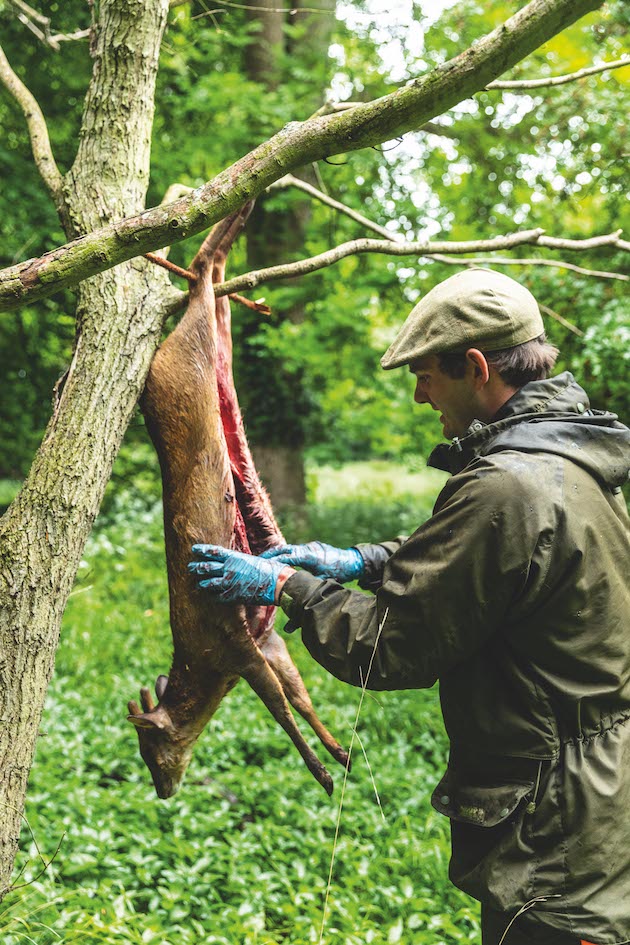
Stewardship grants can give a critical boost to budgets while the price is venison is low
A baseline deer impact assessment was undertaken by Bob. He looked at parcels of woodland, examining specific damage to trees but also understanding the general topography of a woodland and the habitat that was there. Looking at browse lines and understorey species, he was able to gain a strong picture of what was happening with deer numbers and damage in our woodland parcels. Alongside this, we collated cull returns for the past few years as best we could.
Once all of this data was collected, it allowed us to build a plan for the future. Any deer-management plan should be closely coordinated with wider land management goals as well as financial considerations.
The plan should set out a strategy for deer management, including numbers, high seat locations, target species and woodlands, and also a coordinated approach to recording returns and areas of damage, as well as deer movement. Coordination between stalkers is vital. It also helps to facilitate better collaboration between adjoining landowners. Bob cited collaborative culls as the most important tool that can be used to hit deer harder, in areas where their impacts are more significant.
The deer seasons in the UK have been precisely organised to give deer protection when they need it, to produce…
In Northamptonshire, Bob has been coordinating the collaborative approach between landowners. He says that, over the past seven years, those who have engaged most proactively with their own deer management as well as with their neighbours’ have seen the most significant improvement to the quality of woodlands and the biggest reduction in crop loss claims from farmers.
Deer management also opens the door to entry into environmental schemes, specifically Countryside Stewardship. There are grants available through stewardship that can be critical where budgets may not be able to stretch to new high seats or woodland management. This is especially important at the moment, where the low price of venison is not providing an income level sufficient enough to service requirements and, in many cases, makes it unviable for a stalker to even go out shooting by the time they have taken fuel, time and ammunition into consideration.
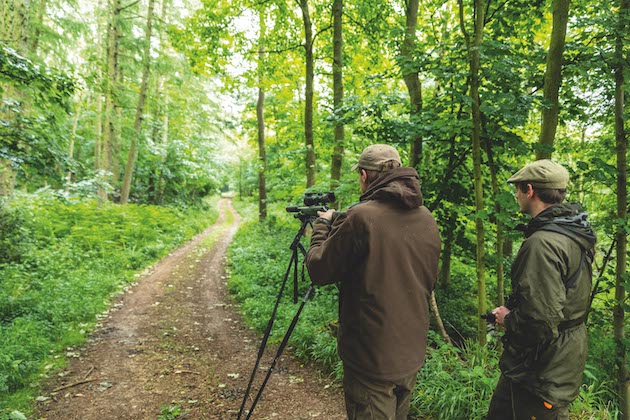
Improved herd quality can generate guided stalking opportunities
While venison prices may be low, secondary income can be derived from guided stalking, though it can be time consuming. By careful selective management, focusing on weaker and older bucks, it is possible to improve the overall gene pool of a herd, but it takes due diligence and time. As the quality of the herd improves, so the increased numbers of ‘trophy’ animals can be used to produce an income. For most deer plans, however, this should be a welcome by-product rather than a direct aspiration or aim.
The management of the deer populations on the estate and the rectifying of their impact is not a quick process and the deer-management plan aims to provide change over the next 10 years. With the right coordination and commitment, as well as following guidance, a slow but sure change in the populations of deer can be driven. The creation of a deer-management plan is an opportunity for engagement with management and for all parties to buy into something that is going to have significant benefits, not only for the land and the estate but for those undertaking stalking and who use woodland areas for recreation. Personally, I much prefer seeing a bluebell in a wood than a bramble.
Get the latest news delivered direct to your door
Discover the ultimate companion for field sports enthusiasts with Shooting Times & Country Magazine, the UK’s leading weekly publication that has been at the forefront of shooting culture since 1882. Subscribers gain access to expert tips, comprehensive gear reviews, seasonal advice and a vibrant community of like-minded shooters.
Save on shop price when you subscribe with weekly issues featuring in-depth articles on gundog training, exclusive member offers and access to the digital back issue library. A Shooting Times & Country subscription is more than a magazine, don’t just read about the countryside; immerse yourself in its most authoritative and engaging publication.

